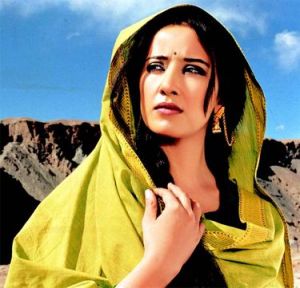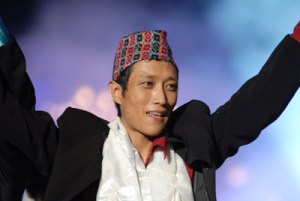
Manisha Koirala - Nepali Beauty
Manisha Koirala (born on August 16, 1970 in Kathmandu, Nepal), is a Nepali actress who works in Indian films, as well as a UNFPA Goodwill Ambassador and social activist. Koirala has primarily worked in Hindi cinema, though she has appeared in a considerable number of Tamil films as well. She is also an accomplished Bharatnatyam and Manipuri dancer.
Making her acting debut in Nepali movie Pheri Bhetaula (1989), Koirala made her acting debut in Bollywood with Subhash Ghai’s top grossing drama Saudagar (1991). She went on to collaborate with some of the most prominent Indian filmmakers of her times, and throughout the 1990s, was one of the best-known actresses in India, mostly recognised for her critically acclaimed performances.
Noted for her willingness to portray strong dramatic characters, Koirala mostly ventured into serious and realistic cinema, and though most of her films have not done well commercially, critics have noted that her niche as an actor remains unharmed irrespective of box office collections.
Early life
Manisha Koirala was born into the politically prominent Hindu Koirala family; Her grandfather Bishweshwar Prasad Koirala was the Prime Minister of Nepal during the late 50s-early 60s, as well as two of her great grand uncles, Girija Prasad Koirala and MP Koirala. She studied at Army Public School, Dhaula Kuan, New Delhi and Vasant Kanya Mahavidhyalaya (VKM) Varanasi. She lived with her grandmother in Varanasi during her studies. Her ambition was to be a doctor, but a modelling stint opened a career path into Bollywood.
Her brother Siddharth Koirala is also an actor, and collaborated with her once in the film Anwar.
In 2004, she returned from New York after receiving a diploma in filmmaking. She became a member of an independent documentary filmmaker’s society.
Career
Her first film was Pheri Bhetaula (We shall meet again), a Nepali movie released in early 1989. Her first Hindi movie was Subhash Ghai’s Saudagar in 1991. The film proved to be a good beginning, as it was the biggest hit of the year.
She starred in a number of unsuccessful films during 1992-1993 until Vidhu Vinod Chopra’s love saga 1942: A Love Story (1994) and Mani Ratnam’s Tamil drama Bombay (1995) came out.Her performance in the latter was particularly appreciated and won her the Filmfare Critics Award for Best Performance. She was also seen in more commercial films, such as Mansoor Khan’s romantic musical Akele Hum Akele Tum (1995) opposite Aamir Khan. Her role of Kiran, an ignored wife who leaves her husband and child in order to fulfill her singing talent and subsequently becomes a popular star, earned her a Filmfare nomination for Best Actress.
Koirala had a particularly successful year in 1996. She received positive reviews for her performance in the drama Agni Sakshi, where she played the role of a battered wife on the run from her mentally sick husband, played by Nana Patekar. The film became one of the biggest hits of that year at the Indian box office. Later that year, she acted in Sanjay Leela Bhansali’s directorial debut, Khamoshi: The Musical. The film saw her playing the role of Annie, a caring daughter to deaf parents. Her performance was highly acclaimed, and won her a second consecutive Filmfare Best Performer Award, as well as a Star Screen Award for Best Actress. One critic from Channel 4 wrote, “Koirala… demonstrates the full range of her acting ability, rather than playing against it as she has had to do in more traditional films. The scene where she shouts at her father through the door, screaming and using sign language even though she knows he can neither see nor hear her, is extremely powerful”
One year later in 1997, she played the leading role alongside Kajol and Bobby Deol in the thriller Gupt: The Hidden Truth. The film became one of the biggest hits of the year.
Manisha Koirala from Gupt: The Hidden Truth (1997)
She went to collaborate once again with Mani Ratnam, and starred in his award-winning film Dil Se (1998) opposite Shahrukh Khan. Her role received similarly good reviews, and earned her several award nominations. Despite performing poorly at the box office in India, the film proved to be a hit overseas.
Success followed for Koirala, and she went on to act in several critically and commercially successful projects. in 1999, she starred in the moderately successful Kachche Dhaage (1999), which was followed by six more releases, the most notable of them being Indra Kumar’s drama Mann. She played the role of a traffic accident victim in the film, which entered into the top five highest grossing films of the year. Her performance in the film won her favorable reviews. Film critic M. Ali Ikram wrote about her performance, “If there is respite for Manisha’s innumerable fans of late, this flick is it. We may not care about hits and flops, but it is painful to watch this acting virtuoso in the innumerable side roles she has been seen in of late. Indra Kumar’s decision to cast Manisha here, is a case of perfect casting, and she never lets him or the audience down. This lady is truly the Meena Kumari of her generation. It is great fun watching Manisha and Aamir Khan’s perfect chemistry opposite one another. The film’s climax has both stars permanently molding a spot for themselves in Bollywood history, and it will have you shedding tears by the bucketful.”
In 2001, she starred in the drama Grahan opposite Jackie Shroff. Her portrayal of a rape victim in the film who quests for justice was appreciated, but the film was a major commercial failure. She next played the main protagonist in Rajkumar Santoshi’s drama Lajja along with an ensemble cast that included Rekha, Anil Kapoor and Madhuri Dixit. The film received a positive reception from critics, and Koirala’s performance was particularly praised.
In 2002, she starred opposite Ajay Devgan in Ram Gopal Verma’s Company. The film was a critical success, as was Koirala’s performance in it, and she won her third Filmfare Best Performer Award. Critic Alok Kumar wrote about her performance, “Manisha Koirala has yet another solid performance to add to her already overflowing portfolio of excellent roles. She has proved herself once again with a powerful and sensitive performance. She holds her own in every scene she’s in and is amazing in her emotional scenes, displaying confidence and maturity. Her new look suits her well. Here’s a girl who can really act.”
After years of success, in 2003 Koirala left the mainstream cinema. She was seen in several low budget films, yet not less challenging roles. She ventured into strong woman-oriented films in 2003, such as Escape From Taliban which won her the BFJA Best Actress Award. She then played the main protagonist in the movie Market where she enacted a role of a prostitute, portraying a whole life story.
After receiving a diploma in filmmaking, she produced the small-budget caper-comedy Paisa Vasool (2004) in which she starred along with Sushmita Sen; this was probably the first ever chick-flick in Indian cinema in that it did not have a male lead nor a love story.
Overall, Koirala starred as the leading role in 6 high-budget, successful Tamil movies: Bombay (1994) co-starring Arvind Swamy, Indian (1996) co-starring Kamal Hassan, Mudhalvan (1999) co-starring Arjun, Aalavandhan (2001) co-starring Kamal Hassan, Baba (2002) co-starring Rajnikanth and Mumbai Express (2005) co-starring Kamal Hassan.
Since then, she has played supporting and leading roles in various unsuccessful films, some of which being well received by critics, such as the historical epic drama Taj Mahal: An Eternal Love Story (2005), the thriller Tum – A Dangerous Obsession (2005), and the horror film Anjaane – The Unknown (2006).
Koirala’s only release of 2007 was Anwar, in which she played a supporting role.
In 2008, she made her comeback to films, with her first leading role since Mumbai Express(2005), in Tulsi, opposite Irrfan Khan. Although pre-release her comeback was described by the media as “shocking”, and the film suffered from poor marketing, her performance as Tulsi, a young homemaker diagnosed with blood cancer, was well received. Taran Adarsh from indiaFM wrote, “Manisha Koirala sinks her teeth in this role and delivers a fine performance.” She next starred in Sirf(2008), a movie about four couples from different strata of life, which portrays the lifestyle of people in metro. The film, which was released without any notice or publicity, was a major critical failure and faced a low box office opening, with most shows being cancelled out due to its poor critical response.
Her first Bengali film Khela directed by Rituparno Ghosh also released the same year along with long delayed Hindi film Mehbooba, both films released on the same day.
In 2009 her releases include actress Deepti Naval’s directorial debut titled Do Paise Ki Dhoop,Char Aane Ki Barrish, Jahnu Barua’s untitled directorial venture where she is all set to play a 80-year-old women, she is also set to star in Mani Ratnam’s Raavan
Awards
Won
- 1996, Filmfare Critics Award for Best Performance, Bombay
- 1997, Filmfare Critics Award for Best Performance, Khamoshi: The Musical
- 1997, Star Screen Award Best Actress, Khamoshi: The Musical
- 2003, Filmfare Critics Award for Best Performance, Company
- 2004, Bengal Film Journalists’ Association Awards, Best Actress, Escape From Taliban
Nominated
- 1995, Filmfare Best Actress Award, 1942:A Love Story
- 1996, Filmfare Best Actress Award, Bombay
- 1996, Filmfare Best Actress Award, Akele Hum Akele Tum
- 1997, Filmfare Best Actress Award, Khamoshi: The Musical
- 1999, Filmfare Best Actress Award, Dil Se
View complete article @ http://en.wikipedia.org/wiki/Manisha_Koirala
Download Manisha Koirala Movies @ http://www.imdb.com/name/nm0463539/
